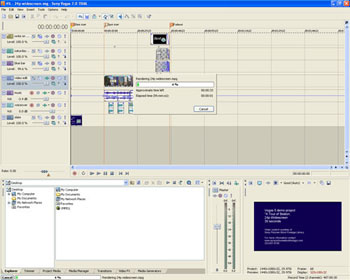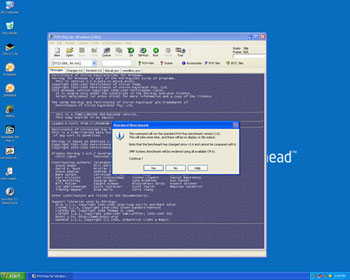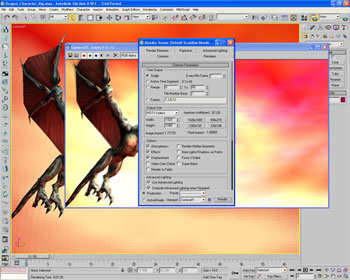Quad Cores: Intel Kentsfield Preview
by Anand Lal Shimpi on September 28, 2006 7:00 PM EST- Posted in
- CPUs
Kentfield Performance
Updated: We initially had a flawed equation for determining percentage differences on the time-based benchmarks. When higher scores are better, it is easy to state that something is a certain percentage faster. For timed tasks, the proper terminology would be how much longer the slow machine takes, or alternately what percentage of the time it would take the faster machine to complete the same task. The percentages now represent an advantage for POV-Ray, PCMark05, and 3DMark06 CPU, while in DivX, Sony Vegas and 3dsmax 8 the percentages are how much longer the X6800 takes. Hopefully, that will help make things clear (as mud).
The DivX performance test is similar to the encoding test we run for our usual CPU reviews, although Intel runs it with higher quality settings so that it stresses the CPU more. Here, the lower clocked, quad-core Core 2 Extreme QX6700 can encode the video in 72.6% of the time of the X6800, or put another way the X6800 takes 37.7% longer. Assuming linear frequency scaling, quad-cores could complete the video encoding in around 66% of the time as dual cores, or dual cores would take 51.4% longer in DivX encoding.
Sony's Vegas application is an Adobe Premier-like application, and rendering video in it is a highly multi-threaded workload. We see that the X6800 takes 50.9% longer than the QX6700. Were we to have equal clock speeds, dual core would take around 66% longer.
Using the POV-Ray multi-threaded beta we ran the application's built in benchmark and noticed a tremendous increase in performance. The QX6700 is over 80% faster than the X6800 thanks to a doubling in the number of cores. Estimating performance scaling at equal clock speeds again, we should get nearly twice the performance with four cores as with two cores, a 98% performance increase.
The 3dsmax 8 test is simply rendering a single frame at high resolution, and the X6800 takes 63.3% longer than the QX6700. Accounting for clock speed differences, dual cores should take about 80% longer than quad cores.
PCMark05's overall score gives you more of an idea of what you can expect for workloads that aren't highly multithreaded, where there's a reduction in performance thanks to the lower clock speed. Looking at the CPU test in specific, there's an advantage to the quad-core setup but it is under 15%, much lower than some of the other workloads. At identical speeds, quad cores should still be a bit faster than dual cores in PCMark05 (8% and 26% faster respectively). This is a far more typical usage scenario for your average user than highly threaded video and 3D rendering applications, unfortunately, and in gaming tests we expect QX6700 to often be slightly slower than X6800.
Rounding off the tests that were loaded on the system we've got 3DMark 06's CPU test, which is obviously multithreaded as is evident by the 57% increase in performance on the QX6700 processor. Were we to have a 2.93 GHz QX6800, the estimated performance would be 73% higher than dual core. Obviously most games today won't show anywhere near that sort of performance improvement due to quad-core, but if Remedy's Alan Wake is any indication of what's to come, quad-core gaming may be a reality starting as early as 2007.
Closing Thoughts
With only a 266MHz difference in clock speed, the new Core 2 Extreme QX6700 isn't too hard of a choice to make. When Intel introduces a lower cost 2.40GHz Core 2 Quad version, things may get a little more complicated, but at the very high end we would rather have four slightly slower cores than two slightly faster cores. We expect that there will be some improvements in multitasking performance, especially if you have a decently fast I/O setup, and don't forget the performance boost you'll get in well threaded applications.
The first quad-core CPUs will be available in November of this year, with more affordable offerings being introduced early next year. Building on top of the already excellent performance of Intel's Core 2 Duo processors, Intel's quad-core solutions will offer a very attractive upgrade path for those users that have invested in the right motherboards today. We're currently working on putting together a list of all currently shipping motherboards that will support Kentsfield to best help you plan for a more upgrade-friendly machine, and we will have the initial list available later today.
Updated: We initially had a flawed equation for determining percentage differences on the time-based benchmarks. When higher scores are better, it is easy to state that something is a certain percentage faster. For timed tasks, the proper terminology would be how much longer the slow machine takes, or alternately what percentage of the time it would take the faster machine to complete the same task. The percentages now represent an advantage for POV-Ray, PCMark05, and 3DMark06 CPU, while in DivX, Sony Vegas and 3dsmax 8 the percentages are how much longer the X6800 takes. Hopefully, that will help make things clear (as mud).
| DivX 6.2.5 w/ XMPEG 5.03 (encoding time in seconds) | |||
| Core 2 Extreme QX6700 (2.66GHz 2x4MB/Quad) |
Core 2 Extreme X6800 (2.93GHz 4MB/Dual) |
Percentage Disadvantage (X6800 vs. QX6700) |
Clock Scaling Estimate (Quad vs. Dual) |
| 77 | 106 | 37.7% | 51.4% |
The DivX performance test is similar to the encoding test we run for our usual CPU reviews, although Intel runs it with higher quality settings so that it stresses the CPU more. Here, the lower clocked, quad-core Core 2 Extreme QX6700 can encode the video in 72.6% of the time of the X6800, or put another way the X6800 takes 37.7% longer. Assuming linear frequency scaling, quad-cores could complete the video encoding in around 66% of the time as dual cores, or dual cores would take 51.4% longer in DivX encoding.
 |
| Click to enlarge |
| Sony Vegas 7.0a (rendering time in seconds) | |||
| Core 2 Extreme QX6700 (2.66GHz 2x4MB/Quad) |
Core 2 Extreme X6800 (2.93GHz 4MB/Dual) |
Percentage Disadvantage (X6800 vs. QX6700) |
Clock Scaling Estimate (Quad vs. Dual) |
| 252.9 | 381.6 | 50.9% | 66.0% |
Sony's Vegas application is an Adobe Premier-like application, and rendering video in it is a highly multi-threaded workload. We see that the X6800 takes 50.9% longer than the QX6700. Were we to have equal clock speeds, dual core would take around 66% longer.
 |
| Click to enlarge |
| POV-Ray Beta 15 (pixels per second) | |||
| Core 2 Extreme QX6700 (2.66GHz 2x4MB/Quad) |
Core 2 Extreme X6800 (2.93GHz 4MB/Dual) |
Percentage Advantage (QX6700 vs. X6800) |
Clock Scaling Estimate (Quad vs. Dual) |
| 2583 | 1431 | 80.5% | 98.55% |
Using the POV-Ray multi-threaded beta we ran the application's built in benchmark and noticed a tremendous increase in performance. The QX6700 is over 80% faster than the X6800 thanks to a doubling in the number of cores. Estimating performance scaling at equal clock speeds again, we should get nearly twice the performance with four cores as with two cores, a 98% performance increase.
 |
| Click to enlarge |
| 3dsmax 8 SP2 (rendering time in seconds) | |||
| Core 2 Extreme QX6700 (2.66GHz 2x4MB/Quad) |
Core 2 Extreme X6800 (2.93GHz 4MB/Dual) |
Percentage Disadvantage (X6800 vs. QX6700) |
Clock Scaling Estimate (Quad vs. Dual) |
| 49 | 80 | 63.3% | 79.6% |
The 3dsmax 8 test is simply rendering a single frame at high resolution, and the X6800 takes 63.3% longer than the QX6700. Accounting for clock speed differences, dual cores should take about 80% longer than quad cores.
| PCMark05 Professional | ||||
| . | Core 2 QX6700 (2.66GHz 2x4MB/Quad) |
Core 2 X6800 (2.93GHz 4MB/Dual) |
Percentage Advantage (QX6700 vs. X6800) |
Clock Scaling Estimate (Quad vs. Dual) |
| Overall | 7594 | 7706 | -1.5% | 8.40% |
| CPU Score | 8485 | 7406 | 14.6% | 26.03% |
PCMark05's overall score gives you more of an idea of what you can expect for workloads that aren't highly multithreaded, where there's a reduction in performance thanks to the lower clock speed. Looking at the CPU test in specific, there's an advantage to the quad-core setup but it is under 15%, much lower than some of the other workloads. At identical speeds, quad cores should still be a bit faster than dual cores in PCMark05 (8% and 26% faster respectively). This is a far more typical usage scenario for your average user than highly threaded video and 3D rendering applications, unfortunately, and in gaming tests we expect QX6700 to often be slightly slower than X6800.
| 3DMark06 CPU score | |||
| Core 2 Extreme QX6700 (2.66GHz 2x4MB/Quad) |
Core 2 Extreme X6800 (2.93GHz 4MB/Dual) |
Percentage Advantage (QX6700 vs. X6800) |
Clock Scaling Estimate (Quad vs. Dual) |
| 3906 | 2487 | 57.1% | 72.76% |
Rounding off the tests that were loaded on the system we've got 3DMark 06's CPU test, which is obviously multithreaded as is evident by the 57% increase in performance on the QX6700 processor. Were we to have a 2.93 GHz QX6800, the estimated performance would be 73% higher than dual core. Obviously most games today won't show anywhere near that sort of performance improvement due to quad-core, but if Remedy's Alan Wake is any indication of what's to come, quad-core gaming may be a reality starting as early as 2007.
Closing Thoughts
With only a 266MHz difference in clock speed, the new Core 2 Extreme QX6700 isn't too hard of a choice to make. When Intel introduces a lower cost 2.40GHz Core 2 Quad version, things may get a little more complicated, but at the very high end we would rather have four slightly slower cores than two slightly faster cores. We expect that there will be some improvements in multitasking performance, especially if you have a decently fast I/O setup, and don't forget the performance boost you'll get in well threaded applications.
The first quad-core CPUs will be available in November of this year, with more affordable offerings being introduced early next year. Building on top of the already excellent performance of Intel's Core 2 Duo processors, Intel's quad-core solutions will offer a very attractive upgrade path for those users that have invested in the right motherboards today. We're currently working on putting together a list of all currently shipping motherboards that will support Kentsfield to best help you plan for a more upgrade-friendly machine, and we will have the initial list available later today.










34 Comments
View All Comments
Mclendo06 - Monday, October 2, 2006 - link
Will this chip have an unlocked multiplier like other "Extreme Edition" processors, or will it be extreme in core count only?Ealdric - Saturday, September 30, 2006 - link
These 4-core chips seem to be out ridiculously soon after the C-2-D. They could (should) have just gone straight to quad. Seems like the vendors will have a hard time keeping up.feraltoad - Saturday, September 30, 2006 - link
You guys see any pricing for the "lower cost" Kentsfields?I thought in the past quad-core? Wut game even uses dual-core? but with Crysis saying it will use multiple cores if they are there. I can't imagine a better way to drive amazing games with crazy physics/AI/enviroments than by using available cores esp. since Aegia is flagging, and the 360 and PS3 are themselves multicored. Plus the video encoding would rawk.
JNo - Friday, September 29, 2006 - link
I know time based percentages can be a little confusing at first but you guys need to sort out your maths...[given and identical task...] "As an example, it is not accurate to state that a score of 40 seconds vs. 80 seconds is twice as fast, but rather that the 40 second score takes half as long or the 80 second score is twice as slow."
Half as long IS twice as fast!! The 40 sec cpu can do the same task twice in the time that it takes the other cpu to do the task i.e. it can work twice as hard ergo it is twice as fast. Twice as fast is 100% faster. Now to be twice as slow it would have to do the task in 160 secs obviously (not 120 secs).
If it did the same task in 20 secs (vs 80 secs), where are we? Well it is 4x as fast! It can do the same task 4 times when the other cpu can only do it once. It is 300% faster (NOT 400%).
Speed difference (as a multiple) is Old time/New time but percentage difference is (Old time/New time -1)
This works the other way round too of course i.e. 80 sec vs 40 sec is 100% slower and 80 vs 20 is 300% slower.
JarredWalton - Friday, September 29, 2006 - link
I updated the text after one reader pointed out the error. Technically, it *is* correct now. 80 seconds is twice as long as 40 seconds; 40 seconds is half as long as 80 seconds. Some like to say "twice as fast" but that is slightly wrong. In situations where higher scores are worse, you have to change the syntax to remain grammatically correct.Time is a duration measurement, not a speed measurement. Would you disagree that 80 seconds is twice as long as 40 seconds? Or that 20 seconds is one fourth as long as 80 seconds? "Fast" is the wrong term to use for such a comparison, other than to say that 40 seconds is faster than 80 seconds. You could talk about rate of travel and say one guy is moving at 40 MPH and that's twice as fast as 80 MPH. Call it a symantic difference of opinion, but I don't like "fast" as a way of describing time.
JNo - Wednesday, October 4, 2006 - link
I understand that time is a duration measurement, not a speed measurement. That's why you have to think of it in terms of the amount of time taken to complete *a given task*, which is a defined amount of work, which will then allow you to make the speed comparison. If a car travels the same distance in half the time another car does (eg 40 secs instead of 80 secs), it is twice as fast. PERIOD."Some like to say 'twice as fast' but that is slightly wrong." - No it isn't! It is undisputably correct!
[quote from following comment] "What is 10% faster than 100 seconds? I suppose you can day it's 90.91 seconds if you want." - I don't just want to - it is! You can not say otherwise without being incorrect!
If you want to make this easier, use the INVERSE of time to define speed (which is scientifically correct - think of the equation distance = speed x time). Now, speed = distance (or workload - eg calculating pi to 2million dp or encoding a video file) divided by the time taken to do said task. Just make the workload = 1 for the sake of argument (as the answer will still be proportionally correct) and you have speed equalling the inverse of time.
This way, 1/40 (faster cpu) is twices as fast as 1/80 (slower cpu) and a cpu that does the task in 20 secs is 4 times as fast as the 80 sec cpu (1/20 is 4x 1/80). Use a calculator if you don't believe me. What if the faster one does task in 73 secs? It's speed is 1/73 compared to 1/80, which is 9.59% faster (1/73 divided by 1/80).
It is not a matter of semantics. It is fact. I am certainly not saying this just to be annoying cos most of the stuff you guys understand (cpu architecture etc) and evaluate goes way over my head. But this is quite straight forward - I just want to try to help you to get it right in future.
vhx500 - Friday, September 29, 2006 - link
.. it's "semantic", not symantic.*Ducks
yacoub - Friday, September 29, 2006 - link
I think his issue is regarding % speed improvement.If something scores 100 points on something, what's a 10% improvement over that? 110 points. What's 100% improvement over 100 points? 200 points.
Thus something that scores 200 points is not 200% faster than something that scores 100 points, it is 100% faster.
There was never a problem with 40s vs 80s being twice as fast. That's the same thing as "taking half as long".
JarredWalton - Friday, September 29, 2006 - link
But that works only for instances where higher is better, without becoming confusing. What's 10% faster than 100 seconds? I suppose you can say it's 90.91 seconds if you want. I prefer to stick with your math and simply state that 110 seconds is 10% slower. :)Kougar - Friday, September 29, 2006 - link
Great idea to create that Kentsfield compatible motherboard list! I've heard that a board needs an EPS12v connector to be truly compatible though... can you confirm this? Already seeing good results with the Abit AW9D-MAX being able to overclock these!Since "Core" processors are the best thing out there for gaming, I can't see why anyone would turn down "Core" based Kentsfield, just simply overclock it. Worst case you get the same performance of a overclocked C2D and have some extra cores... ;)
Again, thanks for the mainboard list!